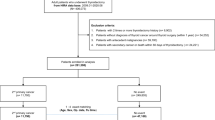Abstract
Purpose
To evaluate the association between 131I therapy for thyroid cancer and risk of developing primary hyperparathyroidism.
Methods
This was a nationwide population-based cohort study of patients with thyroid cancer diagnosed during the period 1997–2008. The data were obtained from the Taiwan National Health Insurance Research dataset. The cumulative 131I dose in each patient was calculated. Hazard ratios (HRs) were calculated using a proportional hazards model to estimate the effect of 131I therapy on the risk of developing primary hyperparathyroidism in the cohort.
Results
A total of 8,946 patients with thyroid cancer were eligible for the final analysis. Among these patients, 8 developed primary hyperparathyroidism during the follow-up period that represented 38,248 person-years giving an incidence rate of 20.9 per 105 person-years. 131I was used in the treatment of 6,153 patients (68.8 %) with a median cumulative dose of 3.7 GBq. The adjusted HRs were 0.21 (95% CI 0.02–1.86) and 0.46 (95% CI 0.10–2.10) for those receiving a cumulative 131I dose of 0.1–3.6 GBq and ≥3.7 GBq, respectively, compared to no therapy. The risk of developing primary hyperparathyroidism did not increase with increasing 131I dose (test for trend p = 0.51). No interaction was found between 131I dose and age (p = 0.94) or 131I dose and sex (p = 0.99).
Conclusion
131I treatment for thyroid cancer did not increase risk of primary hyperparathyroidism during a 10-year follow-up in this study population. Further research with a longer follow-up period is needed to assess late adverse effects beyond 10 years.

Similar content being viewed by others
References
Fraser WD. Hyperparathyroidism. Lancet. 2009;374(9684):145–58. doi:10.1016/S0140-6736(09)60507-9.
Chen HH, Chen YW, Wu CJ. Primary hyperparathyroidism in Taiwan: clinical features and prevalence in a single-center experience. Endocrine. 2010;37(2):373–8. doi:10.1007/s12020-010-9315-7.
Yeh MW, Ituarte PH, Zhou HC, Nishimoto S, Amy Liu IL, Harari A, et al. Incidence and prevalence of primary hyperparathyroidism in a racially mixed population. J Clin Endocrinol Metab. 2013;98(3):1122–9. doi:10.1210/jc.2012-4022.
Tisell LE, Carlsson S, Fjalling M, Hansson G, Lindberg S, Lundberg LM, et al. Hyperparathyroidism subsequent to neck irradiation. Risk factors. Cancer. 1985;56(7):1529–33.
Schneider AB, Gierlowski TC, Shore-Freedman E, Stovall M, Ron E, Lubin J. Dose–response relationships for radiation-induced hyperparathyroidism. J Clin Endocrinol Metab. 1995;80(1):254–7.
Holmberg E, Wallgren A, Holm LE, Lundell M, Karlsson P. Dose–response relationship for parathyroid adenoma after exposure to ionizing radiation in infancy. Radiat Res. 2002;158(4):418–23.
Cohen J, Gierlowski TC, Schneider AB. A prospective study of hyperparathyroidism in individuals exposed to radiation in childhood. JAMA. 1990;264(5):581–4.
Fujiwara S, Sposto R, Ezaki H, Akiba S, Neriishi K, Kodama K, et al. Hyperparathyroidism among atomic bomb survivors in Hiroshima. Radiat Res. 1992;130(3):372–8.
Boehm BO, Rosinger S, Belyi D, Dietrich JW. The parathyroid as a target for radiation damage. N Engl J Med. 2011;365(7):676–8. doi:10.1056/NEJMc1104982.
Bondeson AG, Bondeson L, Thompson NW. Hyperparathyroidism after treatment with radioactive iodine: not only a coincidence? Surgery. 1989;106(6):1025–7.
Rasmuson T, Tavelin B. Risk of parathyroid adenomas in patients with thyrotoxicosis exposed to radioactive iodine. Acta Oncol. 2006;45(8):1059–61. doi:10.1080/02841860500516618.
Tsan YT, Lee CH, Ho WC, Lin MH, Wang JD, Chen PC. Statins and the risk of hepatocellular carcinoma in patients with hepatitis C virus infection. J Clin Oncol. 2013;31(12):1514–21. doi:10.1200/JCO.2012.44.6831.
Lin HW, Tu YY, Lin SY, Su WJ, Lin WL, Lin WZ, et al. Risk of ovarian cancer in women with pelvic inflammatory disease: a population-based study. Lancet Oncol. 2011;12(9):900–4. doi:10.1016/S1470-2045(11)70165-6.
Chang CH, Lin JW, Wu LC, Lai MS. Angiotensin receptor blockade and risk of cancer in type 2 diabetes mellitus: a nationwide case-control study. J Clin Oncol. 2011;29(22):3001–7. doi:10.1200/JCO.2011.35.1908.
Wu CY, Wu MS, Kuo KN, Wang CB, Chen YJ, Lin JT. Effective reduction of gastric cancer risk with regular use of nonsteroidal anti-inflammatory drugs in Helicobacter pylori-infected patients. J Clin Oncol. 2010;28(18):2952–7. doi:10.1200/JCO.2009.26.0695.
Lai MN, Wang SM, Chen PC, Chen YY, Wang JD. Population-based case-control study of Chinese herbal products containing aristolochic acid and urinary tract cancer risk. J Natl Cancer Inst. 2010;102(3):179–86. doi:10.1093/jnci/djp467.
Cooper DS, Doherty GM, Haugen BR, Kloos RT, Lee SL, Mandel SJ, et al. Revised American Thyroid Association management guidelines for patients with thyroid nodules and differentiated thyroid cancer. Thyroid. 2009;19(11):1167–214. doi:10.1089/thy.2009.0110.
Colaco SM, Si M, Reiff E, Clark OH. Hyperparathyroidism after radioactive iodine therapy. Am J Surg. 2007;194(3):323–7. doi:10.1016/j.amjsurg.2007.04.005.
Hundahl SA, Fleming ID, Fremgen AM, Menck HR. A National Cancer Data Base report on 53,856 cases of thyroid carcinoma treated in the U.S., 1985–1995. Cancer. 1998;83(12):2638–48. doi:10.1002/(SICI)1097-0142(19981215)83:12<2638::AID-CNCR31>3.0.CO;2–1.
Cancer registry annual report (2008) Bureau of Health Promotion, Department of Health, Taiwan.
Smallridge RC, Ain KB, Asa SL, Bible KC, Brierley JD, Burman KD, et al. American Thyroid Association guidelines for management of patients with anaplastic thyroid cancer. Thyroid. 2012;22(11):1104–39. doi:10.1089/thy.2012.0302.
Kloos RT, Eng C, Evans DB, Francis GL, Gagel RF, Gharib H, et al. Medullary thyroid cancer: management guidelines of the American Thyroid Association. Thyroid. 2009;19(6):565–612. doi:10.1089/thy.2008.0403.
Conflicts of interest
None.
Author information
Authors and Affiliations
Consortia
Corresponding author
Rights and permissions
About this article
Cite this article
Lin, CM., Doyle, P., Tsan, YT. et al. 131I treatment for thyroid cancer and risk of developing primary hyperparathyroidism: a cohort study. Eur J Nucl Med Mol Imaging 41, 253–259 (2014). https://doi.org/10.1007/s00259-013-2541-5
Received:
Accepted:
Published:
Issue Date:
DOI: https://doi.org/10.1007/s00259-013-2541-5




